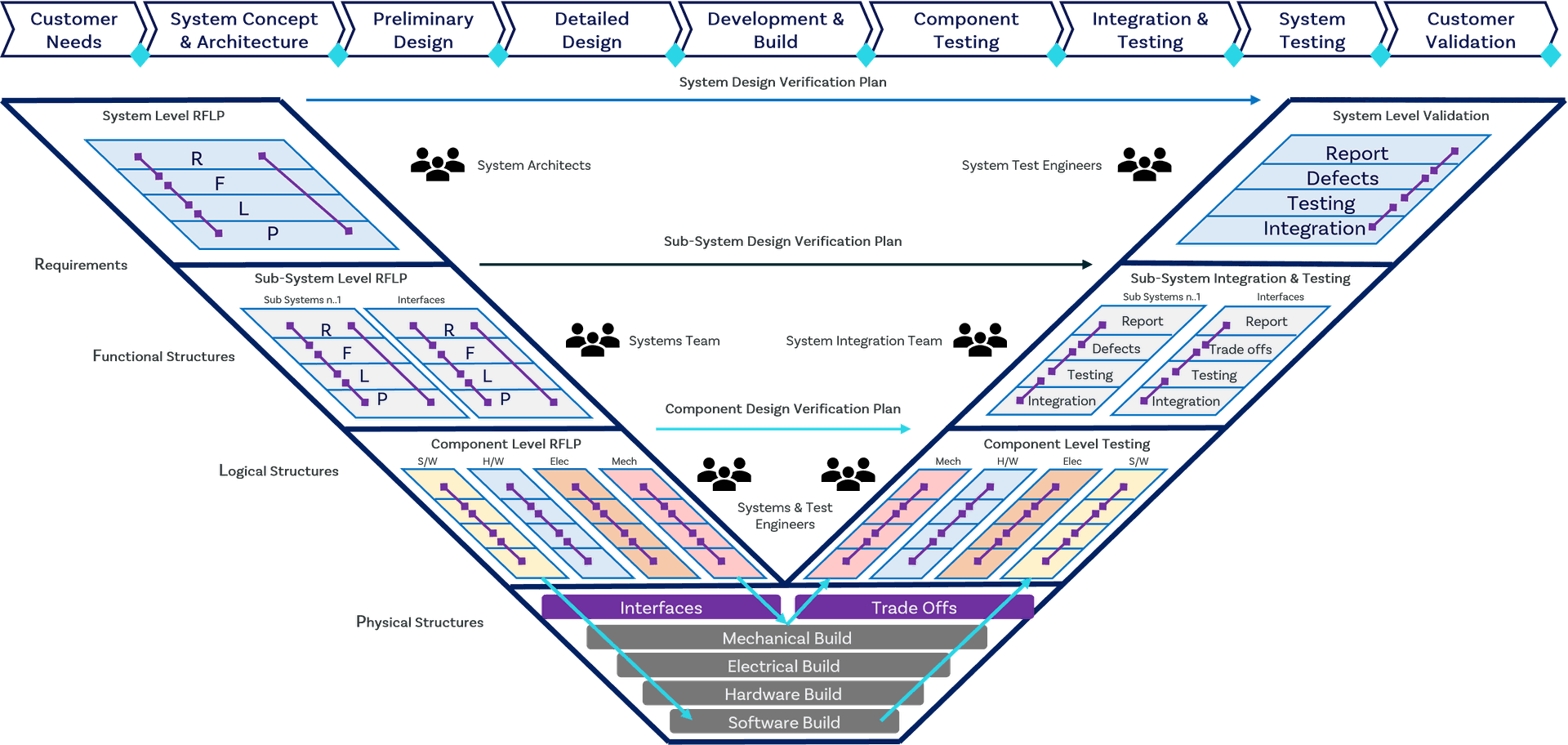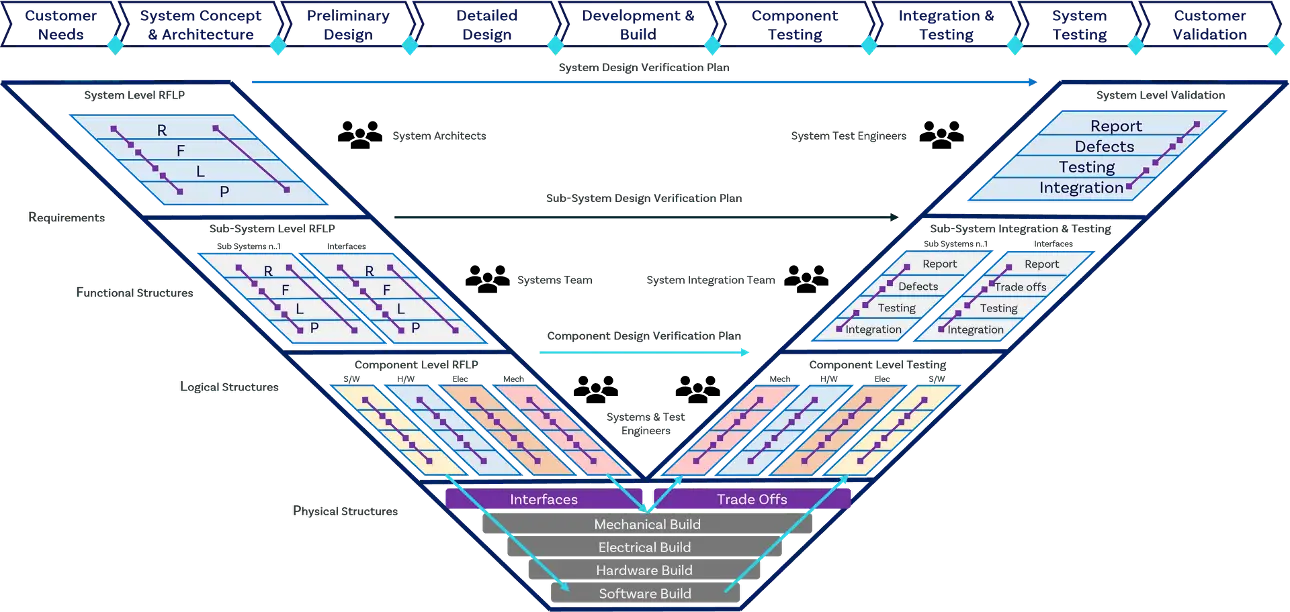
Systems Engineering is a methodology to dissect complexity and allow a systems engineer to define the ‘problem space’ then synthesise and engineer a high-value solution. A key phrase to remember:
'the right system is built, and the system is built right'
We have experienced the complexities and challenges of large projects, across different industries', and know the value of system engineering. We can explain and deliver a step change to your business using a Model-Based approach to complex systems-of-systems.
Lets start discussing your system engineering needs today.
Contact us
What is System Engineering?
System Engineering is a transdisciplinary and integrative approach to delivering what the customer wants and needs, on time, in budget and without negative unintended consequences.
Traditionally many engineered products, services or systems have been developed in a 'siloed' approach, designed by specialists like; mechanical, electrical or software engineers, the final "product" doesn’t always suit the intended purpose or objective.
'Consider the big picture'
This is because a wide breadth of considerations have been missed; like “what happens when..... or what if it fails in this way.... Does the product suddenly pose a real danger, or is now hazardous to health?”
We adopt a Systems Engineering approach that considers the whole problem, the whole system, and the whole lifecycle. This approach towards engineering means that any product developed by us has been designed and extensively tested to perform to specification, taking into account a spectrum of different stakeholders, those stakeholder’ needs, how the product will be used (use-cases) as well as the complete product lifecycle (design, manufacture, operation and decommissioning).
Steps to Success
Understand
Sounds simple, but make sure you understand the problem. Take the the time to document exactly what benefit the system will bring.
Conceptualise
Consider different approaches to deliver on the system needs for the different stakeholders, capturing your thoughts and rationale.
Consider
Systems exist within an eco-system of other systems. Think about the adjacent systems that may need to be developed or tested.
Requirements
User needs' need to be translated into as system, sub-system or individual technical requirement specifications.
Interfaces
Interface management to core and paramount to Systems Engineering, you can't be an expert of everything, so collaborate together.
Track
Defining a plan and tracking that as changes occur is fundamental to successful systems or project delivery.
What is Model Based System Engineering?
MBSE is a tool in dissecting and reducing complexity and allowing the systems engineer to define the ‘problem space’ then synthesise and engineer a high-value solution. The point at which a problem becomes too complex is defined by capacity for a systems engineer (or team of systems engineers) to retain knowledge and awareness of both the problem space and the system conceived to remedy the problem.
This is supported by documented observations such as George Miller’s (1956) theory that suggests most adults can store between 5 and 9 items in their short-term memory; with this in mind, the average systems engineer would only be able to accurately assess the viability of an engineered solution if it comprised no more than 10 or so components (and even fewer if those components are multifunctional or operate in different states or modes).
MBSE adopts computing technologies to enable a singular systems engineer to orchestrate, manage, and deliver significantly complex systems with an enhanced degree of functional assurance;
'are you building the right system, and are you building the system right'
MBSE is an approach to systems engineering that uses models as the primary means of information exchange and analysis throughout the system development lifecycle. Instead of relying primarily on documents, MBSE emphasizes visual and formal representations of systems, which helps improve communication, understanding, and collaboration among stakeholders.
Model-Centric Approach: Systems are represented using models that capture requirements, design, analysis, verification, and validation.
Integration: MBSE integrates various engineering disciplines and perspectives, facilitating a holistic view of the system.
Formal Methods: It often employs formal modelling languages (like SysML) that provide a clear and standardized way to describe systems.
Automation and Simulation: Models can be used to simulate system behaviour, allowing for early identification of issues and performance evaluation.
Lifecycle Support: MBSE supports the entire lifecycle of a system, from conception and design through development and operation to retirement.
What are the benefits of MBSE?
Improved Communication: Visual models are often easier to understand than text-heavy documents.
Reduced Errors: Early detection of inconsistencies and potential issues.
Enhanced Collaboration: Stakeholders from different disciplines can work together more effectively.
Better Traceability: Changes and requirements can be tracked more efficiently throughout the lifecycle.
many more....
What can MBSE offer?
Opportunity 1:
Identify where “complexity” exists in the context of your business, categorised as either:
Essential complexity – an component or element of a system that cannot be broken down, reduced, or otherwise simplified.
Accidental complexity – an unintended complexity caused by people, processes, and tools, specifically the level of chaos in their behavioural interactions.
Realised Value 1:
This process defines what complexities are within your businesses control and those which are beyond your control. It allows decision-makers to focus on aspects of complexity which can be viably reduced, increasing quality and performance of the organisation and the systems being developed.
Secondly, essential complexities need not be re-modelled time and time again, they can be re-used from one model to the next yielding both efficiency and quality gains.
Opportunity 2:
Identify and minimise gaps in understanding, which may otherwise cause the wrong system to be developed.
Systems engineers understand that when developing a successful and well-engineered system, it is not just the User Needs that must be considered. Of equal importance are:
How the system will be deployed.
Where it will be deployed.
How it will be verified.
How it might change over time.
How it will be retired.
All these aspects provide valuable insights which will govern the specification of the best-suited system. MBSE enables systems engineers to foresee complexities and anticipate both challenges and issues. This therefore assures that the correct system is conceived and importantly, the correct decisions are made at the right time to prevent avoidable defects/issues.
Realised Value 2:
The ability to model something successfully is (inherently) a confirmation that the systems engineer fully understands that which is being modelled. If something cannot be modelled, or it proves troublesome, it is simply because it is not understood.
Secondly, modelling provides a means to foresee a system throughout its lifecycle. This is exceptionally powerful when making key decisions early in the development lifecycle (or conducting trade-off analysis)
Opportunity 3:
Simplify communication across the organisation and to customers.
Issues with communication occur across any hierarchical or organisational level, across any interaction, interface, or exchange. This is true for person-person, organisation-organisation, and system-system exchanges. Surprisingly, not everyone speaks the same language and context often plays a key role in defining the “correct” interpretation.
MBSE requires the definition of model rules, syntax, and notation practices (in most instances adopting System Modelling Language, SysML) which standardises communication across people, departments, organisations, and systems.
Realised Value 3:
Modelling mandates the creation of a standalone ontology. Ontology will standardises language and therefore what your business calls a “User Need” will be formally defined at an organisational level. Furthermore, interactions between these entities are also defined, e.g. how a “User Need” entity interacts with “System Requirements” or a “System Specification”. Who these entities are used by, where they are used and why are now apparent to everyone in the organisation.
Secondly, MBSE is a visual modelling approach, this means diagrams are quick to explain, interactions are clearly identifiable and recognisable, minimising the time spent reading unnecessarily wordy documents.
As a two-fold benefit, this means it is easier to engage with individuals who may not be systems engineers.
Design For Manufacture
Lets start solving your MBSE challenges today
What are the requirements and challenges facing you in 2024 and beyond?

